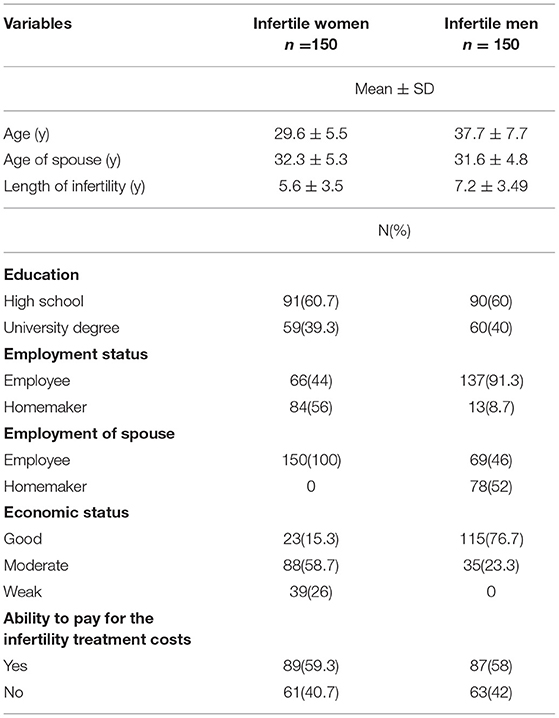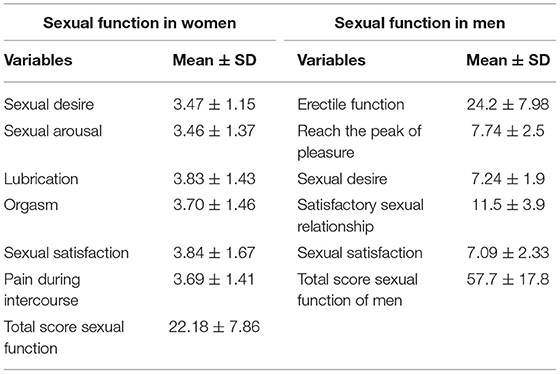- 1Reproductive Health Promotion Research Center, Ahvaz Jundishapur University of Medical Sciences, Ahvaz, Iran
- 2Midwifery, Ahvaz Jundishapur University of Medical Sciences, Ahvaz, Iran
- 3Gynecology, Ahvaz Jundishapur University of Medical Sciences, Ahvaz, Iran
- 4Biostatistics, Ahvaz Jundishapur University of Medical Sciences, Ahvaz, Iran
Background: The issue of infertility is a worldwide challenge, estimated to affect around 50 million couples. This study aimed to evaluate the relationship between infertility stress and sexual function in men and women with infertility.
Methods: In this cross-sectional study, 300 men and women with infertility were recruited. A demographic questionnaire, the Fertility Problem Inventory, the Female Sexual Function Scale (FSFI), and the International Index of Erectile Function (IIEF) were used to collect data. Independent t-test, Chi-square, and linear and logistic regressions were used to assess the data.
Results: The total score of sexual function in women and men was 22.18 ± 7.86 and 57.7 ± 17.8, respectively. Infertility duration and the ability to pay for the costs of infertility treatment had a significant relationship with sexual function in women. A significant association was found between communication concerns and sexual function scores in men with infertility. Infertile women had more sexual concerns, while infertile men had more communication concerns.
Conclusion: This study showed that women with infertility had more infertility stress than men with infertility. Women with higher infertility duration and the inability to pay for the infertility treatment costs impaired sexual function. Women with infertility had more sexual concerns, while Men with infertility had more communication concerns. Policymakers need to consider strategies such as counseling for men and women with infertility to help them cope with their problems, especially their psychological problems. The lack of random enrollment of participants and lack of control group were the limitations of this study.
Background
Infertility is a challenging worldwide issue which is estimated to affect around 50 million couples (1). In other words, every sixth couple is affected by infertility (2). The prevalence of primary clinical infertility in Iran was estimated to be 20.2% in 2019 (3). The causes of infertility can be listed as follows: non-ovulation or irregular ovulation (20%), tubal factor (30%), semen migration factor (10%), and male factor (30%) (2).
Infertile couples may experience psychological problems such as stress and depression. A study in Sweden showed that 10.9% of infertile women and 5.1% of men suffered from depression while 14.8% of women and 4.9% of men suffered from anxiety (4). A study by Patel et al. (5) on 300 infertile women showed that the prevalence of stress was 80%, and there was a significant association between stress and infertility type.
Infertility stress may impair sexual function and satisfaction in men and women with infertility. A study by Facchin et al. (6) showed that infertile women with higher infertility stress were more likely to have sexual dysfunction. Also, there is evidence that shows that the male partners of infertile women experience more stress and higher sexual dysfunction (7). Sexual function in infertile women may depend on the fertility of their partners. A study by Ghavi et al. (10) showed that sexual assertiveness in women with a fertile partner was higher in comparison with women having an infertile partner, and sexual burnout in women with an infertile partner was higher (8). Furthermore, infertile women experience more stress and depression and have a lower sexual quality of life (9), and the more years of infertility and its treatment, the lower the sexual function in women (10). Winkelman et al. (11) in their study showed that when the cause of infertility is the female factor, and in women younger than 40 years with primary infertility, the sexual function is more impaired.
A study in Iran showed that the prevalence of sexual dysfunction among infertile women was 64.3%, with sexual desire being more impaired than other sexual domains (12). Despite these studies, there is scarce information about the relationship between infertility stress and sexual function in infertile men and women.
Objectives
This study was designed to evaluate the relationship between infertility stress and sexual function in men and women with infertility using validated questionnaires.
Materials and Methods
This was a cross-sectional study in which 150 infertile women and 150 infertile men were recruited from the Infertility Center in Imam Khomeini Hospital in Ahvaz, Iran. Women and men with the following criteria were enrolled in this study: literate, married and having sexual intercourse at least for one year, and being diagnosed with primary infertility diagnosed by a gynecologist. Women and men with known physical or psychological disorders were excluded from the study.
Ethical Consideration
The protocol of this study was approved by the Ethics Committee of Ahvaz Jundishapur University of Medical Sciences (Ref. ID: IR.AJUMS.REC.1398.144). All participants provided written informed consent prior to data collection. All participants were assured about the confidentiality of data. For preserving the privacy of participants, data were collected in a private room in the hospital and only one of the researchers (SA) was available in case participants had any questions.
Sampling
The following formula was used for computing the sample size:
In this formula, the power of the study was set at 90%, α = 0.05, r = 0.28 (minimum correlation coefficient between infertility stress and sexual function in infertile men and women from a pilot study). The total sample of women and men was set to be 130, and assuming 15% for non-responders, the total number of samples was estimated to be 300 (150 for women and 150 for men). The convenient sampling method was used for sampling.
Measurements
In this study, we used four questionnaires to collect data. A demographic questionnaire which included questions about the participant's age, age of the spouse, duration of infertility, educational attainment, employment status, employment status of the spouse, economic status, and the ability to pay for the infertility treatment costs was designed by the researchers. The validity of the demographic questionnaire was approved using content validity. This questionnaire was checked by six faculty members and gynecologists.
The Fertility Problem Inventory was used for measuring the infertility stress of infertile women and men. This scale was developed by Newton et al. (13) and has 46 questions in five categories including social concerns, sexual concerns, communication concerns, child-free lifestyle, and need for parenthood (13). The answers to questions are rated from strongly disagree to strongly agree, and a six-item Likert scale is used for scoring the items, with one indicating “strongly disagree” and six indicating “strongly agree”. The minimum and maximum scores of this questionnaire are 46 and 276, respectively. The scores between 46 and 92 indicated low infertility stress, 92–184 show moderate infertility stress, and scores>184 represent high infertility stress. This questionnaire was validated in Iranian patients with infertility by Omani-Samani et al. (12, 19). A Cronbach's alpha of 70% was obtained for all domains. Exploratory factor analysis revealed five factors for the instrument.
The Female Sexual Function Index (FSFI) consists of 19 questions for assessing the sexual function of women. These questions are organized into six dimensions: sexual desire (two questions), arousal (four questions), lubrication (four questions), orgasm (three questions), sexual satisfaction (three questions), and pain during intercourse (three questions). A six-item Likert scale is used for scoring this index with zero indicating that women did not have sexual intercourse during the last month and five indicating women always having sexual problems. The scores of each domain are multiplied by a certain factor. The minimum and maximum scores for this questionnaire are 6 and 36, respectively, and scores of more than 26 indicated favorable sexual function (14). The Persian version of this questionnaire was validated in Iran by Fakhri et al. (15). The test–retest reliability of FSFI was confirmed by obtaining 0.73-0.86, and this tool was shown to be internally consistent. Confirmatory factor analysis confirmed the validity of all domains of FSFI.
The International Index of Erectile Function (IIEF) is an index for assessing the sexual function of male participants in the past four weeks. This questionnaire consists of five dimensions as follows: erectile function (six questions), orgasmic function (two questions), sexual desire (two questions), sexual satisfaction (three questions), and overall satisfaction of sexual function (two questions). These questions are scored from zero to five, with higher scores indicating better sexual function. The minimum and maximum scores in this questionnaire are 15 and 75, respectively. Scores between 15 and 25 indicated low sexual function, scores between 25 and 50 indicated moderate sexual function, and scores >50 indicate good sexual function (13). The validity and reliability of this questionnaire were assessed and approved by Pakpour et al. (16) in Iran.
Procedure
All eligible women and men were approached in the infertility clinic of the hospital (Imam Khomeini). After informed consent was obtained from the participants, they were requested to complete three questionnaires. The female participants completed a demographic questionnaire, FSFI, and the Fertility Problem Inventory, while the male participants completed a demographic questionnaire, IIEF, and Fertility Problem Inventory. One of the researchers (SA) was available in case participants had any questions.
Statistical Analysis
Statistical analysis was performed using the statistical software SPSS 22 (SPSS Inc. Chicago, IL, United States). The normality of continuous variables was examined using the Shapiro-Wilk's W-test. Continuous variables were reported as mean ± SD whereas categorical data were expressed as numbers (percentage). An independent-samples t-test was used to compare the mean of different infertility stress scopes of infertile men and women. In addition, multiple linear regression analysis was applied to determine the parameters most predictive of the infertility stress in men.
A step-wise backward regression algorithm was used to choose variables entering into the final model. All variables that had p-values less than 0.1 in a univariate analysis were selected to be examined in this algorithm. In addition, univariate and multivariable binary logistic regression analyses were performed to calculate crude and adjusted odds ratios of the association between the explanatory variables and the sexual function status in infertile women, with the respective 95% CI and p-values (likelihood ratio statistic). Variables associated with the outcome (good sexual function/ undesirable sexual function) with P < 0.2 in the univariate analysis were included in a multivariate logistic regression model. Backward stepwise logistic regression modeling was then used to obtain a subset of the factors associated with the status of sexual function in infertile women.
Results
Table 1 shows the demographic characteristics of infertile men and women participating in this study. The mean age of infertile women and men was 29.6 ± 5.5 and 37.7 ± 7.7, respectively. The duration of infertility was 5.6 ± 3.5 and 7.2 ± 3.49 in infertile women and men, respectively. Almost half of the infertile women and men were able to pay for the infertility treatment costs.
Table 2 shows the mean sexual function scores in female and male infertile patients. The total score of sexual function in women and men was 22.18 ± 7.86 and 57.7 ± 17.8, respectively.
Table 3 shows the mean infertility stress in infertile women and men. The scores of concerns about a child-free lifestyle and the need for parenthood were significantly higher in infertile women compared to infertile men.
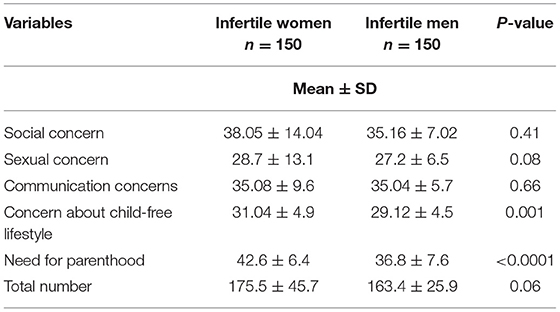
Table 3. Comparison of mean scores of different areas of infertility stress in infertile women and men.
There was a significant association between the total score of infertility stress with a total score of sexual function in both male and female genders. The total score of sexual function in men was negatively correlated with the total score of infertility stress (r = −0.292; p < 0.05). In infertile women, the total score of infertility stress has a negative association with the total score of sexual function (r = −0.857; p < 0.0001) (data are not shown in tables).
Good sexual function was observed in 67 (44.6%) infertile women. The short infertility duration was a significant variable in relation to better sexual function (OR: 0.46; 95%CI: 0.35–0.58; P < 0.0001). Other variables had a significant effect on the sexual function of infertile women (Table 4). Results of multivariate logistic regressions for the prediction of good sexual function in infertile women are reported in Table 4. Of all 10 adjusted variables in the multivariate logistic regression model, infertility duration, ability to pay for infertility treatment, and sexual concerns had a significant effect on good sexual function. Infertile women with the highest sexual concern had experienced undesirable sexual function (OR Adjusted: 0.86; 95% CI: 0.79–0.93; P < 0.0001).
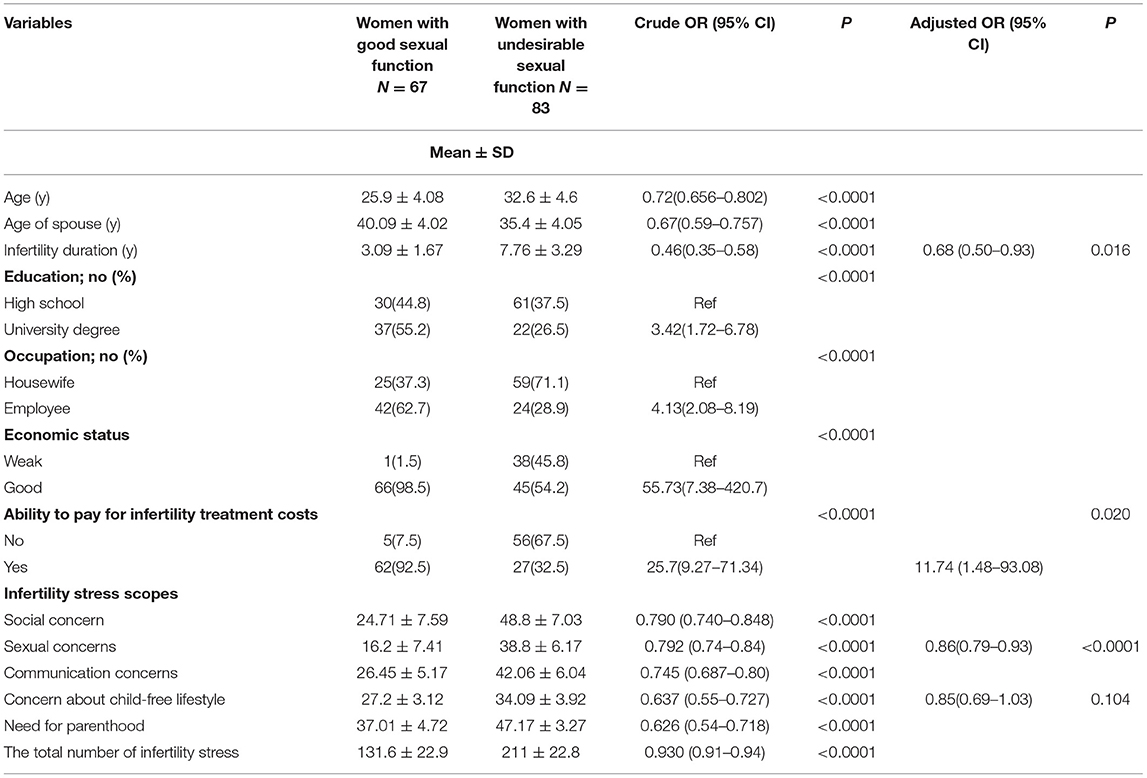
Table 4. Results of univariate and multiple logistic regression models for predicting good sexual function in infertile women.
Univariate logistic regression indicated that infertile women with higher scores in all scopes of infertility stress were significantly more likely to have undesirable sexual functions (Table 4). Per one-unit increase in score of social concern, sexual concern, communication concern, concern about life without a child and need to be parent scopes, infertile women had a 21, 20.8, 25.5, 36.3, and 37.4% reduction in odds of having good sexual function, respectively (Table 4).
In addition, the multivariate logistic analysis indicated that infertile women with higher scores of sexual concern after adjustment for infertility duration, ability to pay for infertility treatment, and a score of concerns about a child-free lifestyle, were at higher risk of undesirable sexual function (OR = 0.86; 95% CI: 0.79–0.93; p < 0.001).
In simple regression analyses, all scopes of infertility stress were correlated negatively with sexual function in infertile male participants. Per one-unit increase in score of social concern, sexual concern, communication concern, concern about child-free lifestyle and need to parenthood, sexual function of infertile men shows reduction as follows: social concern (β = −0.63; p = 0.002), sexual concern (β = −0.82; p < 0.0001), communication concern (β = −0.95; p < 0.0001), concern about child-free lifestyle (β = −1.04; p = 0.001), and the total score of infertility stress (β = −0.24; p < 0.001) (Table 5).
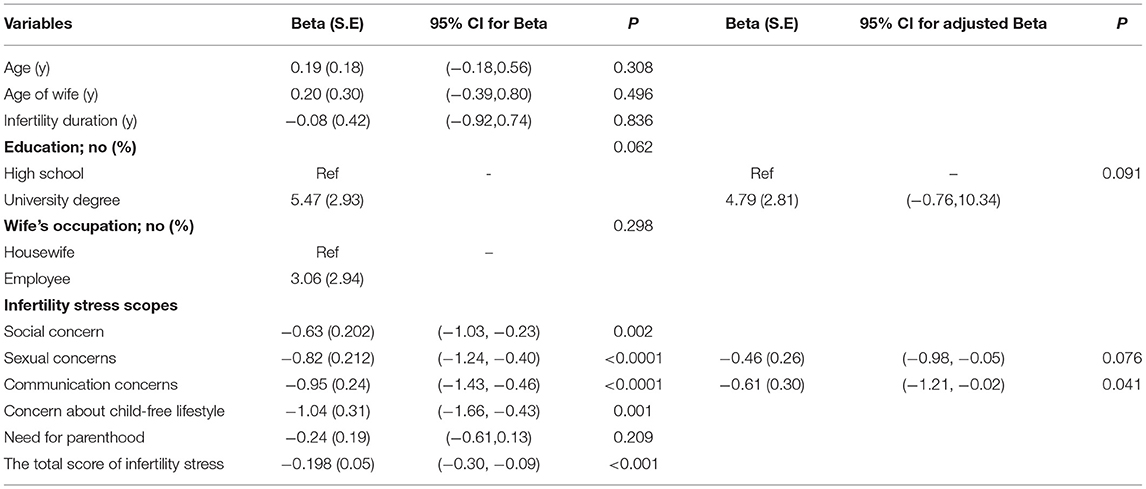
Table 5. Results of univariate and multiple linear regression analyses to determine parameters most predictive of sexual function in infertile men.
Multiple linear regression analysis demonstrated that communication concern was significantly correlated with lower levels of sexual function in men after controlling the effects of other predictors (β = −0.61, 95% CI: (−1.21, −0.02) (Table 5).
Discussion
This study was designed to investigate the relationship between infertility stress and sexual function in infertile women and men. The results of this study showed that most infertile women had a low sexual function score, while most infertile men had good sexual function. There is evidence that infertility can negatively affect sexual function in women and men, and 43–90% of infertile women and 48–58% of infertile men have been reported to suffer from sexual dysfunction (17). Tao et al. (18) also suggested that infertility and its treatment could negatively affect the sexual function dimensions such as sexual self-esteem and sexual relationship. Our results are in line with those of Starc et al. (17) and Tao et al. (18). In a systematic review, Omani-Samani et al. (12, 19) found that 64% of Iranian infertile women had sexual dysfunction. In our study 83 (55.3%) women had an undesirable sexual function, which is almost in line with the study of Omani-Samani et al. (12, 19).
The results of the present study showed that the scores of concerns about a child-free lifestyle and the need for parenthood were significantly higher in infertile women compared to infertile men. In total, 67 (44.6%) of the infertile women in the present study had normal sexual function. Women with shorter infertility duration had better sexual function. In addition, women who could pay for infertility treatment were more likely to have better sexual function. In their study on 300 women with primary infertility, Patel et al. (5) found that almost 80% of infertile women had infertility stress and that duration of infertility and infertility type were among the predictors of stress among these women.
According to the results of the present study, infertile women with higher sexual concerns had an undesirable sexual function. Also, a significant association was found between communication concerns and sexual function scores in infertile men. Factors such as infertility treatment and using assisted reproductive technology, having timed intercourse, and psychological factors may impair sexual function in infertile women (20). Bai et al. found that infertility treatment costs and social concerns were associated with depression in men, while ethnicity and sexual concerns were significantly correlated with depression symptoms in women (21). These results are in line with our findings, except for the fact that infertility treatment costs were related to sexual function in infertile women and not in men. In the present study, infertile women and men were from different families, and no couples participated in this study. Most of the women in this study did not have a good economic status, while most infertile men (76.7%) enjoyed a good economic position.
A study by Salomao et al. (22) showed that infertile women do not have higher sexual dysfunction in comparison to the women without infertility, but women with more anxiety or depression showed more sexual dysfunction. It is not known, however, whether women experience sexual dysfunction due to infertility or depression or if stress following infertility can cause sexual dysfunction. Of course, it is hardly disputable that infertility is a complex problem and has many negative effects on various organs (23).
Sexuality is a complex phenomenon, and there is a need for more studies to prove the causal relationship between infertility, stress, and sexual dysfunction in infertile women and men.
Strengths and Limitations of the Study
In this study, we assessed the relationship between infertility stress and sexual function among 300 infertile women and men. One of the limitations of this study is that the participants were not recruited randomly. Second, we did not have a control group. Finally, the questions in the questionnaires required the participants to answer based on their memory, and thus the results may have been affected by recall bias.
Conclusion
This study showed that infertile women suffer from higher infertility stress than do infertile men. Women with higher infertility duration and inability to pay for the infertility treatment costs had impaired sexual function. Infertile women had more sexual concerns, while infertile men had more communication concerns. Policymakers need to consider strategies such as counseling for infertile men and women to help them cope with their problems, especially their psychological problems.
Data Availability Statement
The raw data supporting the conclusions of this article will be made available by the authors, without undue reservation.
Ethics Statement
The studies involving human participants were reviewed and approved by Ahvaz Jundishapur University of Medical Sciences. The patients/participants provided their written informed consent to participate in this study.
Author Contributions
SA, PA, RN, and MT were contributed to the conception of this study. SA collected the data. SA and EM were contributed to data analyzing. SA, EM, and PA were contributed in data interpretation. PA was responsible for writing the paper. All authors seen and approved the content of the manuscript.
Funding
This study was funded by Ahvaz Jundishapur University of Medical Sciences, Ahvaz, Iran. The funder did not play any role in conception, data collection, data interpretation, and writing this manuscript.
Conflict of Interest
The authors declare that the research was conducted in the absence of any commercial or financial relationships that could be construed as a potential conflict of interest.
Publisher's Note
All claims expressed in this article are solely those of the authors and do not necessarily represent those of their affiliated organizations, or those of the publisher, the editors and the reviewers. Any product that may be evaluated in this article, or claim that may be made by its manufacturer, is not guaranteed or endorsed by the publisher.
References
1. Mascarenhas MN, Flaxman SR, Boerma T, Vanderpoel S, Stevens GA. National, regional, and global trends in infertility prevalence since 1990: a systematic analysis of 277 health surveys. PLoS Med. (2012) 9:e1001356. doi: 10.1371/journal.pmed.1001356
2. Brugo-Olmedo S, Chillik C, Kopelman S. Definition and Causes of Infertility. Reprod Biomed Online. (2001) 2:41-53 doi: 10.1016/S1472-6483(10)62187-6
3. Akhondi MM, Ranjbar F, Shirzad M, Ardakani ZB, Kamali K, Mohammad K. Practical difficulties in estimating the prevalence of primary infertility in Iran. Int J Fertil Steril. (2019) 13:113–7. doi: 10.22074/ijfs.2019.5583
4. Volgsten H, Skoog Svanberg A, Ekselius L, Lundkvist Ö, Sundström Poromaa I. Prevalence of psychiatric disorders in infertile women and men undergoing in vitro fertilization treatment. Hum Reprod. (2008) 23:2056–63. doi: 10.1093/humrep/den154
5. Patel A, Sharma PS VN, Narayan P, Binu VS, Dinesh N, Pai P. Prevalence and predictors of infertility-specific stress in women diagnosed with primary infertility: a clinic-based study. J. Hum. Reprod. Sci. (2016) 9:28. doi: 10.4103/0974-1208.178630
6. Facchin F, Somigliana E, Busnelli A, Catavorello A, Barbara G, Vercellini P. Infertility-related distress and female sexual function during assisted reproduction. Hum Reprod. (2019) 34:1065–73. doi: 10.1093/humrep/dez046
7. Song SH, Kim DS, Yoon TK, Hong JY, Shim SH. Sexual function and stress level of male partners of infertile couples during the fertile period. BJU Int. (2016) 117:173–6. doi: 10.1111/bju.13201
8. Shahraki Z, Tanha FD, Ghajarzadeh M. Depression, sexual dysfunction and sexual quality of life in women with infertility. BMC Womens Health. (2018) 18:e92. doi10.1186/S12905-018-0584-2
9. Dong M, Xu X, Li Y, Wang Y, Jin Z, Tan J. Impact of infertility duration on female sexual health. Reprod Biol Endocrinol. (2021) 19:157. doi: 10.1186/S12958-021-00837-7
10. Ghavi F, Mosalanejad L, Abdollahifard S, Golestan Jahromi M. Male Infertility and its impact on women's sexual behaviors: need attention to psychological problem as a psychological rehabilitation. IRJ. (2017) 15:87–94. doi: 10.18869/nrip.irj.15.2.87
11. Winkelman WD, Katz PP, Smith JF, Rowen TS. The sexual impact of infertility among women seeking fertility care. Sex Med. (2016) 4:E190–7. doi: 10.1016/j.esxm.2016.04.001
12. Omani-Samani R, Amini P, Navid B, Sepidarkish M, Maroufizadeh S, Almasi-Hashiani A. Prevalence of sexual dysfunction among infertile women in iran: a systematic review and meta-analysis. Int J Fertil Steril. (2019) 12:278–83. doi: 10.22074/ijfs.2019.5395
13. Newton CR, Sherrard W, Glavac I. The fertility problem inventory: measuring perceived infertility-related stress. Fertil Steril. (1999) 72:54–62. doi: 10.1016/S0015-0282(99)00164-8
14. Rosen R, Riley A, Wagner G, Osterloh IH, Kirkpatrick J, Mishra A. The International Index of Erectile Function (IIEF): a multidimensional scale for assessment of erectile dysfunction. Urology. (1997) 49:822–30. doi: 10.1016/S0090-4295(97)00238-0
15. Fakhri A, Pakpour AH, Burri A, Morshedi H, Zeidi IM. The female sexual function index: translation and validation of an iranian version. J Sex Med. (2012) 9:514–23. doi: 10.1111/j.1743-6109.2011.02553.x
16. Pakpour A, Mohammadi Zeidi I, Yejaninejad S, Buri A. Validation of a translated and culturally adapted iranian version of the international index of erectile function. J. Sex Marital Ther. (2013) 40:541–51. doi: 10.1080/0092623X.2013.788110
17. Starc A, Trampus M, Junkic DP, Rotim C, Jukic T, Mivsek AP. Infertility and sexual dysfunctions: a systematic literature review. Acta Clin Croat. (2019) 58:508–15. doi: 10.20471/acc.2019.58.03.15
18. Tao P, Coates R, Maycock B. The impact of infertility on sexuality: a literature review. Australas Med J. (2011) 4:620–27. doi: 10.4066/AMJ.20111055
19. Omani-Samani R, Almasi-Hashiani A, Shokri F, Maroufizadeh S, Vesali S, Sepidarkish M. Validation study of the fertility problem inventory in iranian infertile patients. Middle East Fertil Soc J. (2017) 22:48–53. doi: 10.1016/j.mefs.2016.07.002
20. Bokaie M, Simbar M, Ardekani SMY. Sexual behavior of infertile women: a qualitative study. Iran J Reprod Med. (2015) 13:645–56.
21. Bai CF, Sun JW, Li J, Jing WH, Zhang XK, Zhang X, et al. Gender differences in factors associated with depression in infertility patients. J Adv Nurs. (2019) 75:3515–24. doi: 10.1111/jan.14171
22. Salomao PB, Navarro PA, Salata Romao APM, Lerri MR, Silva Lara L. Sexual function of women with infertility. Rev Bras Ginecol Obstet. (2018) 40:771–8. doi: 10.1055/s-0038-1673699
Keywords: infertility stress, female sexual function, male sexual function, infertile men, infertile women
Citation: Amraei S, Abedi P, Nikbakht R, Tadayon M and Maraghi E (2022) Does Infertility Stress Impair Sexual Function in Infertile Women and Men? A Cross-Sectional Study in Iran. Front. Med. 9:896538. doi: 10.3389/fmed.2022.896538
Received: 15 March 2022; Accepted: 16 May 2022;
Published: 22 June 2022.
Edited by:
Faiza Alam, University of Brunei Darussalam, BruneiReviewed by:
Rehana Rehman, Aga Khan University, PakistanNida Farooqui, Aga Khan University, Pakistan
Nida Zahid, Aga Khan University, Pakistan
Copyright © 2022 Amraei, Abedi, Nikbakht, Tadayon and Maraghi. This is an open-access article distributed under the terms of the Creative Commons Attribution License (CC BY). The use, distribution or reproduction in other forums is permitted, provided the original author(s) and the copyright owner(s) are credited and that the original publication in this journal is cited, in accordance with accepted academic practice. No use, distribution or reproduction is permitted which does not comply with these terms.
*Correspondence: Parvin Abedi, cGFydmluYWJlZGlAeW1haWwuY29t
 Samira Amraei1,2
Samira Amraei1,2 Parvin Abedi
Parvin Abedi Roshan Nikbakht
Roshan Nikbakht